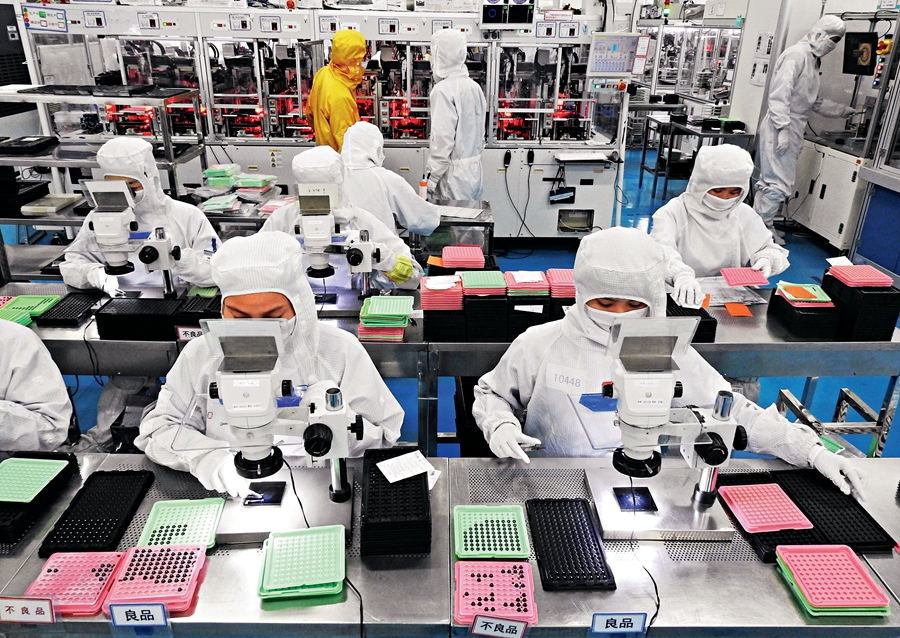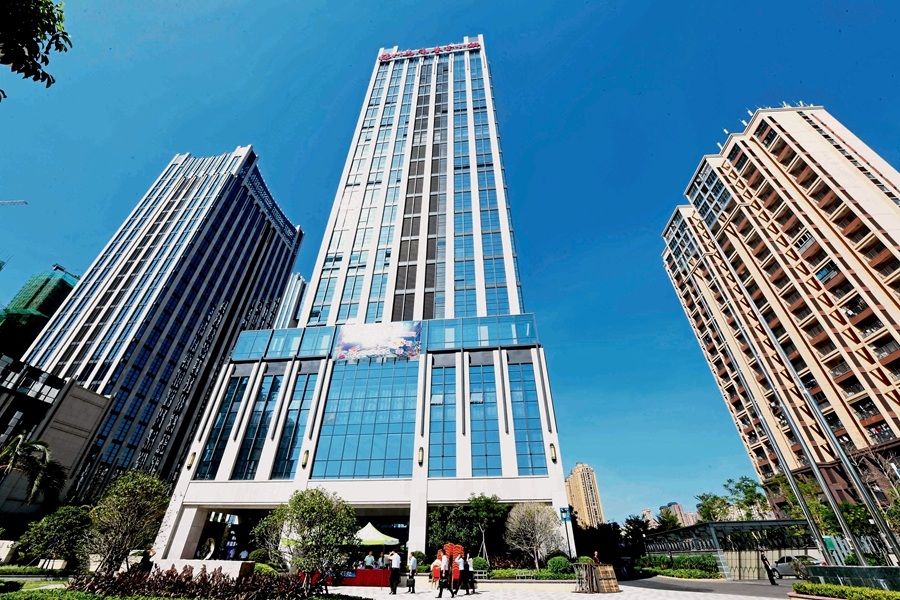By staff reporter ZHANG HUA
THE central economic work conference convened at the end of 2017 drew up plans for China’s economic development in 2018 after reviewing progress over the previous five years and analyzing the current economic situation. The meeting concluded that, along with Chinese socialism, the Chinese economy has entered a new era, which features the shift from high-speed growth to high-quality growth.
The meeting also set forth Xi Jinping Thought on Socialist Economy with Chinese Characteristics for a New Era.
China Today interviewed Zhang Yansheng, chief researcher of the China Center for International Economic Exchanges and researcher with the Academic Committee of National Development and Reform Commission, on the economic growth of higher quality which China is striving for.
Three Key Phrases
For years, China’s GDP growth goal has been of broad concern worldwide. The latest central economic work conference nevertheless played down the GDP projection, and instead put more emphasis on the quality of economic development. Zhang Yansheng parsed out such development through three key phrases.
Workers at a precision technology company in Lianyungang City, Jiangsu Province, make micro optical lens.
The first is the transition from high-speed growth to high-quality growth. Before understanding this change, Zhang said that we must ask the question: why is growth rate underlined? “This is because over 40 years of reform and opening-up, we Chinese people have been telling ourselves: losing any time in development, the Chinese nation will find no place in the world. We are convinced that development is of paramount importance, holding the key to solving all problems facing the nation. It is therefore given top priority in state governance.”
Forty years on, China has come to a new stage of development, in which it must aim for better rather than fast growth. According to World Bank statistics, China’s GDP now stands at US $11 trillion, ranking second globally. At this magnitude, the gain of every single percentage point is a huge amount. During a visit to Latin America, Zhang was told by his local counterparts: “We are not worried about the slowing of China’s economic growth. Though its GDP growth rate fell to 6.7 percent in 2016, China’s GDP still expanded by US $700-800 billion. The cake remains big. What concerns us is how much can we get from this cake?”
“From this perspective, China has come to a phase where the quality of economic growth matters more than the velocity of growth,” Zhang said. “For over 30 years we underscored the increase in GDP and per capita GDP, now the focus is on the quality of growth. Accordingly, the Five-Sphere Integrated Plan (to promote coordinated economic, political, cultural, social, and ecological advancement) and the Four-Pronged Comprehensive Strategy (to make comprehensive moves to finish building a moderately prosperous society in all respects, deepen reform, advance law-based governance, and strengthen Party self-governance) are introduced.”
A staff member of Feima Robotics tests the company’s F300 drone on December 14, 2017.
As the report to the 19th National Congress of the Communist Party of China (CPC) said, the principal contradiction facing Chinese society has evolved. What the country now faces is the contradiction between unbalanced and inadequate development and the people’s ever-growing needs for a better life. Chinese people now have more expectations for not only material life, but also for democracy, rule of law, fairness and justice, security and the environment. “Obviously what China is pursuing is well-rounded human development and all-round social progress,” Zhang said.
The second key phrase is to develop a modernized economy. To do this, the report to the 19th CPC National Congress set out six missions – furthering the supply-side structural reform; making China a country of innovators; pursuing a rural vitalization strategy; implementing a coordinated regional development strategy; accelerating efforts to improve socialist market economy; and making new ground in pursuing opening-up on all fronts.
As Zhang sees it, furthering the supply-side structural reform comes first in importance. This reform has three goals. The first is to move from high-speed economic growth to high-quality growth. The second is to meet the people’s demands. The report to the 19th CPC National Congress admits that the Chinese people now have higher and more diversified demands, which have to be met by increasing supply and improving the quality of development. To this end we must work hard for better quality, higher efficiency, and more robust drivers of economic growth through reform, raising total factor productivity. The third is to deepen reforms. This must be carried out in a market-based and law-based manner to achieve desired results.
At the 16th meeting of the Central Leading Group for Financial and Economic Affairs, held on July 17, 2017, Chinese President Xi Jinping articulated: “We must further improve the investment and market environment, pick up the pace of opening-up, reduce the cost of market operations, establish a stable, fair, transparent and predictable business environment, and speed up in building an open new economic system to promote sustainable, healthy development of the Chinese economy.”
One measure China has implemented to improve its investment environment is the system of pre-establishment of national treatment plus a negative list. It is part of the promise the country made at the Fourth Plenary Session of the 18th CPC Central Committee to ensure the government acts strictly within the law, doing only what the law allows, and fulfilling every obligation prescribed by the law.
The third key phase is to improve the market environment through reforms. The Third Plenary Session of the 18th CPC Central Committee made it clear that reform to the economic system is the priority of China’s efforts to deepen reforms in all areas. The central issue in this regard is to properly handle the relationship between the government and the market, allowing the former to perform better and the latter to play a decisive role in resource allocation.
Zhang held that the reform is imperative. “Like humanity, the market economy goes through different phases as it matures. Market mechanisms, therefore, must be reformed accordingly.”
Principal Contradiction to Be Addressed
In seeking high-quality development China must tackle the principal contradiction facing Chinese society – the contradiction between unbalanced and inadequate development and the people’s ever-growing needs for a better life.
Unbalanced and inadequate development is the remnant effect of an earlier policy. In the early years of the reform and opening-up, China encouraged a minority of the population to get rich first, designated the eastern coastal regions to spearhead the drive, and opened itself primarily to Western countries. Tremendous achievements have been made in the following decades, but accompanied by imbalances in national development. In the coming years China will instead take the path of robust, balanced, sustainable, and inclusive development.
Fuzhou Mawei Fund Town is inaugurated in Mawei District of Fuzhou City, Fujian Province, on September 26, 2017.
Zhang has observed encouraging changes in this direction. “The most pronounced is the adoption of the innovation-driven development strategy,” he said. “In developed regions, such as Guangdong, Jiangsu, Zhejiang, Shanghai, Beijing, Tianjin, and Shandong, the research and development strength exceeds the average level in OECD (Organization for Economic Cooperation and Development) countries. What we should do in the next 10, 20, and 30 years is to keep increasing investment in innovation until it reaches a decent level. In this process, a horde of world-level universities, research institutes, business innovation platforms, key generic technologies, and a system of public technical services will come into being, profoundly transforming China’s growth drivers.
New Thought Guides New Development
Zhang agreed that China has entered a new era, and now stands at the starting point of a new journey. “For instance, in the past five years the share of the service sector in China’s GDP expanded from 44 percent to 53 percent. It is obvious that the innovation driver is working. Under structural reforms, new models and forms of business take up a greater share of the Chinese economy. These lay the ground for Xi Jinping Thought on Socialist Economy with Chinese Characteristics for a New Era.”
The latest central economic work conference endorsed Xi Jinping Thought on Socialist Economy with Chinese Characteristics for a New Era, which was elaborated in the report which the president, who is also general secretary of the CPC Central Committee, delivered to the Party’s 19th National Congress in October 2017.
Responding to the fact that the Chinese economy has advanced from the phase of high-speed growth to that of high-quality growth, Xi in his report called on the nation to accelerate the building of an industrial system that promotes coordinated development of the real economy with technological innovation, modern finance, and human resources. Zhang gave his take in this regard.
First, the president attaches great importance to real economy. He declared in the report: “In developing a modernized economy, we must focus on the real economy, give priority to improving the quality of the supply system, and enhance our economy’s strength in terms of quality.”
Second, scientific and technological innovation is already a strong driver of the economy in developed Chinese regions. The research and development intensity in Jiangsu, for instance, scored 2.66 in 2016, bolstered by a whopping investment of RMB 202.6 billion for the year. The intensity was 2.56 in Guangdong, 3.0 in Tianjin, and 4.1 in Shenzhen, all exceeding the average level in developed countries. In comparison, the intensity is 2.4 by average in OECD countries.
But it cannot be overlooked that in central China, the local economy is still investment-fueled, and in western China the propeller remains to be natural resources. This is why the report to the latest CPC national congress made a point to address unbalanced and inadequate development, the centerpiece of Xi Jinping Thought on Socialist Economy with Chinese Characteristics for a New Era. The solution of this problem lies in, first of all, scientific and technological innovation.
Third, building a modern financial system is another key point of Xi Jinping Thought on Socialist Economy with Chinese Characteristics for a New Era. China’s savings rate is the worlds’ highest, but a modern financial system is absent to transform the huge bank savings into investment. To change this situation, China must increase direct financing, and nurture a multi-layered capital market system that docks with the global capital market.
Fourth, in the new era of the Chinese economy, it is a pressing task to cultivate a competent work force, attract talent, and retain them.
With these new visions, Xi Jinping Thought on Socialist Economy with Chinese Characteristics for a New Era will guide China towards growth of better quality.


